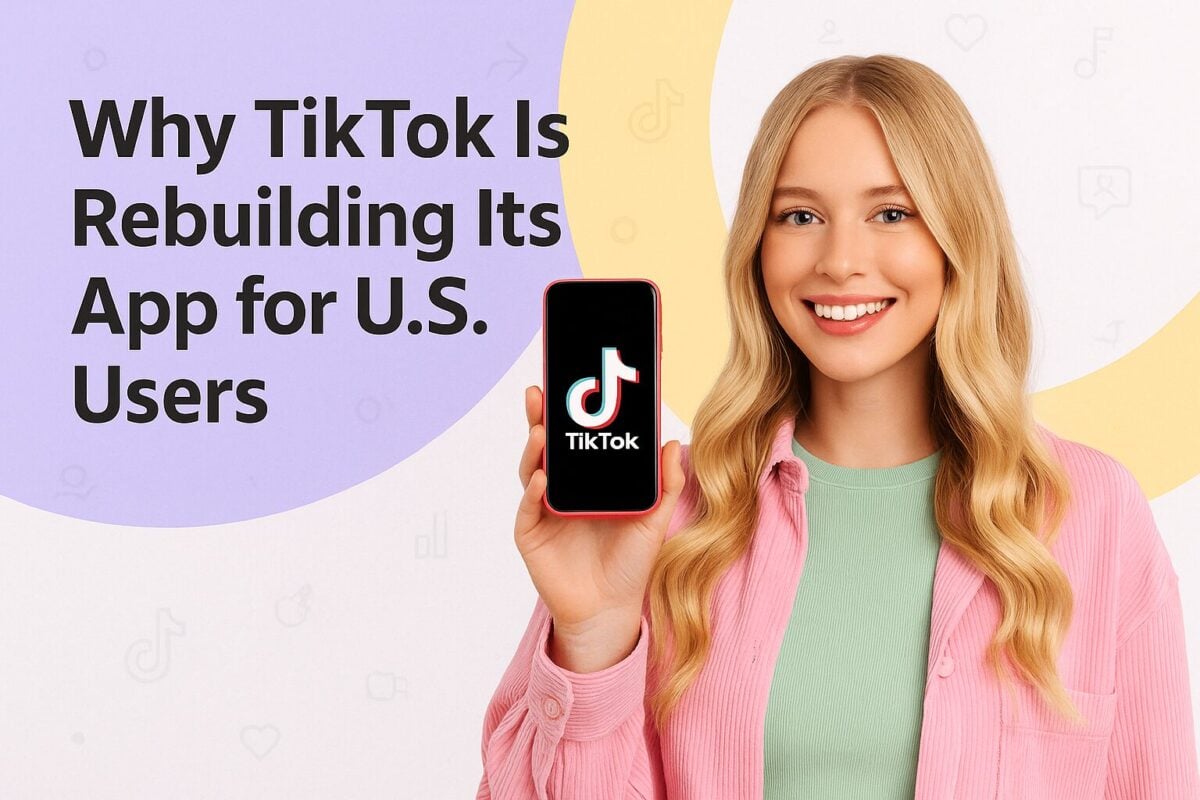Looking for a complete video marketing guide? This one includes all you’ll need to get started with video. You’ll learn how video marketing fits into content marketing and what the benefits of using video marketing are. You’ll also get a simple 3-step process to help you create videos and four ways to promote them for maximum exposure.
The Complete Video Marketing Guide:
- What is a Video Marketing Strategy?
- How Important is Video Marketing?
- What are the Benefits of Video Marketing?
- Is Video Marketing Better than Content Marketing?
- Where Video Fits Into the Content Marketing Funnel
- What are the Types of Video Marketing?
- How do I Create an Effective Video Marketing Strategy that Drives Business?
- What is a Video Marketing Campaign?
- How to Create Videos to Promote Your Business
- Use Your Persona
- Use Before and After States
- Storyboard Your Idea
- What are the Best Video Marketing Tools?
- Where to Promote Your Videos
What is a Video Marketing Strategy?
A video marketing strategy is a strategic approach marketers use to communicate specific messages to buyers as they move through the buying process.. Marketers use video to attract, educate, and convert prospects into leads.
If you’ve been in the content marketing world, this sounds like content marketing because it is content marketing. Video marketing strategy fits into content marketing strategy.
How Important is Video Marketing?
Video is huge! Much of its growth has been driven by elements like internet accessibility and lower bandwidth costs, and how fast mobile devices have taken over the world. There are also other important contributing factors to take into consideration too, such as the large number of video platforms that offer on-demand video and live streaming nowadays.
Take YouTube. Today, over 2 billion people use the platform each month. There’s an estimated 500 million hours of video uploaded each minute, and it’s where you can go to find videos on almost any topic.
But how does this translate into solid business value? Video is a type of content. But unlike static content (think blog posts, infographics, and whitepapers), it’s far more engaging. With moving imagery and sound, video is able to communicate much more and in doing so is an effective way of holding your buyer’s attention.
Video is also consumed en masse on platforms where your target customers spend their time. For example, Facebook in its Q2 2021 investor report reports over 2.75 billion users. Facebook also receives 8 billion daily video views. It’s a no-brainer that you’d want to get in front of an audience that loves watching that much video.
What are the Benefits of Video Marketing?
Besides access to a large audience through social media and video-on-demand platforms, here’s what you can look forward to when using video marketing:
Strong Emotional Responses
Video is as close to a real-life experience as content marketing can come. And any savvy marketer understands that where there’s a chance to make a personal connection, there’s a chance to forge a strong customer relationship. On a more scientific level, video offers sensory stimulation, and using music along with video has been proven to induce specific emotional states.
An Ever-present Sales Person
Video marketing is also the perfect addition to your salesforce. Today, buyers research new ideas, products, and services at different times. And with access to mobile devices, this means from anywhere. Using video to promote products and services takes the burden off your sales team, especially after hours. As an online sales tool, video can educate buyers who need specific information before investing in your product.
Is Video Marketing Better than Content Marketing?
Video marketing is a form of content marketing. And it’s one of the most versatile types of content available. It can be used at different stages of your content marketing funnel. It’s also growing in search. YouTube videos are indexed by Google, offering brands a chance to rank for competitive keywords organically.
As a versatile medium, you can create complete video marketing funnels on platforms like YouTube to help walk your buyers from product search through to purchase. Video marketing can also be very telling. Using metrics like clicks and watch-time, you can develop a clearer picture of which videos are working to help your brand grow.
Where Video Fits Into the Content Marketing Funnel
The content marketing funnel is a simple way to describe the transition buyers experience as they consume more content from your brand. Here’s what a content marketing funnel using video looks like and the metrics you should be tracking:
Top-of-Funnel Video Attracts Buyers
Video at the top of your funnel is used to promote your brand and begin planting seeds in the minds of prospects. Prospects at the top of your funnel have a problem but often don’t know how to define it or don’t completely understand what it means for them.
Your job is to use video marketing to address each challenge or problem your buyer has. Buyers who watch your videos become better-informed. They begin to use the information you’ve provided as a foundation for learning.
And this is essential. If you can serve as a trusted source of information for your audience, your brand wins and holds the position of authority. It also stays top-of-mind and is likely the first choice when buyers are ready to commit to a solution.
Key Metrics: Video View Count and Engagement
View count and engagement are great signs that your content is effective. Both show that people are interested in it, and when they like, comment and share it, they deem it useful.
Middle-of-Funnel Video Educates Buyers
Your middle-of-funnel content is all about expanding on the educational foundation. At this stage, you’ve helped buyers better qualify what their challenges and problems are, making them problem-aware. Your goal at the middle of the funnel is to start answering bigger questions about what solutions to these problems are. This is also where you’ll give buyers a look at your solution and why it’s best-suited to do the job.
Key Metrics: Watch-time
Watch-time shows that people are watching your videos. Longer video watch-time indicates that people are interested in your content.
Bottom-of-Funnel Video Converts Buyers
With solution-aware buyers, it’s time to get them to commit. At the bottom of your funnel, videos need to take the form of proof. Your focus is to convince buyers who are ready to invest in your solution, or a solution, to take that step.
Key Metrics: Conversions
Sign-ups, leads generated, or sales count as conversions. If you’re able to track either back to a video, that’s proof that people found it helpful.
What are the Types of Video Marketing?
There are many types of videos you can create for your brand. Here you will find 10 videos you need to promote your brand and solution and where they fit into the content marketing funnel.
Top of Funnel Videos
Q&A Videos
Q&A videos are perfect problem-awareness videos. They help people learn more about a certain issue in a format most people are familiar and comfortable with. By using questions and answers, viewers are also able to quickly pull information they need and feel like they’ve gained value.
Megan Margot used a Q&A video to answer questions people have about weight loss.
101 or Beginner Videos
101/Beginner videos are just that. They offer foundational knowledge. Often, they distill concepts or help people better frame challenges they face.
Ignite Spot Accounting Services gives viewers, who may feel like they aren’t getting value from their account, a set of questions to ask.
Live Stream Videos
Live streams can be used at any stage of the content marketing funnel. Going live helps brands create a more personalized customer experience, and with Q&A sessions included, can help accelerate the sales cycle by addressing objections prospects may have.
Jessica Kellgren-Fozard, a YouTuber, hosts a live baking session for her audience and makes money through donations.
Explainer Videos
Explainer videos are highly popular because they demystify much about what a brand’s value proposition is. They explain how products work, what buyers can expect, and more.
Blockgeeks demystifies cryptocurrency with friendly images.
Middle-of-Funnel Videos
How-to Videos
How-to videos offer practical steps customers can take to perform a specific task. These are helpful at the middle of the funnel to show how certain features of a product may work, and post-sales as support tools.
Jeff Cavaliere shows how to get abs in 22 days with a series of exercises anyone can perform at home.
A Web Series
Web series are powerful brand-building tools. In some circles, web series are referred to as episodic content; content that’vs connected and takes your buyer through a learning cycle with a specific pay-off at the end.

Source: youtube.com
Vimeo uses a collection of videos to show how integral video is for small businesses.
Bottom-of-Funnel Videos
Demonstration Videos
Demos are instrumental in the final stretch of the content marketing funnel. Like how-to videos, they show how a product or service works. These can be a general overview or in-depth depending on what your research has shown customers to want.
Pat Flynn created a helpful demo on CovertKit. In it, he covers what email marketing looks like in 2019, why ConvertKit is a great tool, and how to use the platform.
Success Stories and Testimonials
Not everyone will jump at your product or service. People often need proof that it will work for them and social proof helps get those buyers over the line. Success stories and testimonials serve as third-party validation for people looking to buy your product and deciding whether to trust your brand.
Interviews
Interviews are like success stories, only a little more in-depth. They are also more personable and touch on specific challenges customers faced and how your solution saved the day. Interviews can also be used in the middle of the funnel. By interviewing subject matter experts, you can position your brand as a thought-leader.
Reviews
Reviews showcase products and services. Unlike demos and how-tos, they are more thorough. And these work well to lay any concerns about the capabilities of a product or service.
How do I Create an Effective Video Marketing Strategy that Drives Business?
To build a successful video marketing strategy you must have a basic structure in place. You’ll need to know who your ideal customers are, what challenges they face (related to your product), and what they want out of a solution like yours. You also need a way to transform ideas into video content and know how to promote your videos.
Let’s dig into understanding your ideal customer.
In the content marketing sphere, a term that’s often used to describe an ideal customer is “persona”. This is a document with a collection of characteristics that your customers share. And having a firm grasp of who your ideal customer is matters big time.
Think of it this way: if you don’t know why a customer has a specific problem, it’s hard to position your product in a way that addresses the problem, or how solving the problem improves your customer’s life.
For example, you could think that people who need to travel from one place to another need to buy a car. Upon closer inspection, your ideal customer lives too far from school to walk. They may be interested in a boosted board or a bicycle, or another cost-effective solution that’s also eco-friendly.
How to Create a Persona
To build your persona, you’ll need to research your ideal customer. The best form of research is primary research, where you speak to and gather information from your ideal customers. Secondary research is helpful, too. It validates primary research and helps form a clearer picture of what your ideal customer is all about.
DigitalMarketer has an easy-to-follow framework. In its case, a persona is called a “customer avatar”.
Source: digitalmarketer.com
Here’s a look at the information DigitalMarketer recommends to create an effective persona for your video marketing content:
Goals and Values
These are important achievements that your customer wants to realize, along with values that guide their actions.
Using our example from earlier, we know that our ideal customer wants to get from point A to point B. That’s a goal. But they also want to do so without harming the environment. They believe themselves to be eco-friendly and care about saving the planet from harmful fossil fuels.
Sources of Information
Sources of information are just that, platforms or places your customer turns to for information about the challenge they have. If you’re looking to video marketing as a tool for promoting your brand and products and want to get in front of your audience, YouTube is a great place to start.
Demographics Information
Demographic information helps solidify the image you have of your customer. It’s essential if you want to make your video marketing as personable and relevant as possible. DigitalMarketer recommends finding an image of your ideal customer, giving them a name, and sourcing other important information.
What should you list under demographic information? Find out:
- How old your costumes typically are
- Do they identify as male, female or other?
- Are they married or single?
- Where do they typically live?
- What jobs do they have?
- Do they have kids? If so, how old are they?
At a glance, these may not seem like pertinent questions to answer, but picture this:
Imagine knowing that your ideal customer was an eco-conscious teen before committing tens or hundreds of thousands of dollars to a campaign to sell them a large diesel-powered pick-up truck...
Challenges and Pain Points
This is where things get even more exciting. Uncovering challenges and pain points your customer experiences adds a degree of clarity that any brand can benefit from. People don’t typically spend money on products or services unless they solve a problem. And this applies to every product or service available today. But if you don’t understand their problems and challenges intimately, you’ll miss out on your best chance at winning more business.
Challenges differ from pain points, and it’s critical to understand how. Challenges are best described as elements that prevent strategic growth or your customer from realizing success. Pain points are better understood as issues that make your customer feel like they aren’t winning in their situation. Pain points manifest negative or undesirable emotions.
For example, a challenge your ideal customer may have is getting to school on time. A pain point could be the fear of arriving late for class and having to apologize to a teacher and the embarrassment associated with being tardy.
Objections to the Sale
No matter what you’re selling, you will come across people who just won’t buy. And that’s okay. There are also people who may want to buy but need to better appreciate what you have to offer. Often, this group of people has objections to committing to a solution. These are best thought of as education gaps. Knowing what education your ideal customer needs helps you understand what will make your video marketing content more effective.
In our example of teens who want to find an eco-friendly way to get to school on time, a bicycle retailer is going up against boosted boards. An objection to owning a bicycle could be that it takes up more space. Another could be that a bicycle is heavier.
Knowing of these objections, you could position bicycles as a great alternative by marketing them as a better way to stay in shape. You could also position bicycles as more eco-friendly and affordable over time. Boosted boards come with battery packs that will die out. And recycling or disposing of batteries can be a pain unless you know where to take your old battery pack to dispose of them correctly.
With your persona in hand, it’s time to start creating your video. But pointing and shooting won’t do. Neither will a single video. You’ll have to think about video marketing campaigns and create campaigns to drive strong messages home for your target market.
What is a Video Marketing Campaign?
A video marketing campaign is a collection of videos strategically planned to deliver a specific outcome. As a versatile medium that can be used through the content marketing funnel, you can create a series of videos that serve each stage of the funnel, and connect them all to create a larger campaign that leads to a sale.
How to Create Videos to Promote Your Business
To get started on your video marketing campaign, you’ll pull on research you’ve already done, and lean into the art of storytelling. Here are three easy-to-follow steps to use to create impactful videos:
Use Your Persona
Use your persona as a guide. In your research, you’ve uncovered challenges and pain points your ideal customer experiences. List these and dig deeper. For each item, look for more information around what the cause of a challenge and pain point is.
Take the challenge of wanting to arrive at school on time. To dig deeper for more insight on this challenge, ask your target audience:
- What being on time represents to them
- What solutions they’ve tried already and why didn't they stick to them?
- Is there an acceptable degree of difficulty buyers expect when using a solution?
These questions are a great starting point.
Remember: Your goal is to know what drives your target customer so you can best align your product with their needs.
Use Before and After States
The Before and After Grid was a concept introduced by DigitalMarketer. In many ways, once you understand how to identify before and after states for your personas, you’ll wonder how you ever marketed without using them.
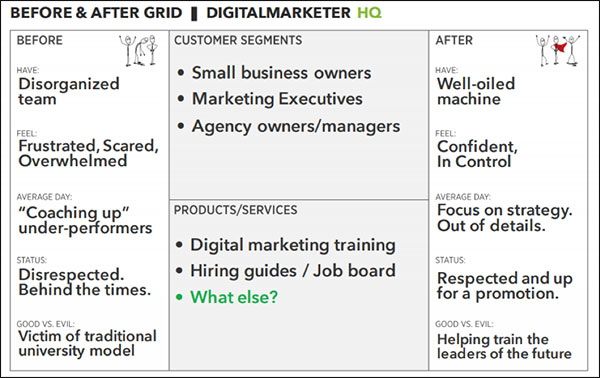
Source: digitalmarketer.com
Before and after states highlight the material and emotional states your customer experiences. The grid also accounts for what your customer’s average day looks like, how they view their status or position before, the “evil” that plagues your customer, and the “good” that defeats the “evil”, helping your customers improve their lives. This applies to before and after they have experienced your brand. In the video marketing world, you can apply this by identifying:
- What position is your ideal customer in, in relation to an ideal scenario for them? E.g. unable to get to school on time vs arriving before class starts and settling in to start learning.
- How do they feel in their current state? Frustrated, guilty, embarrassed for constantly being late vs feeling relaxed and more confident in themselves and their ability to be punctual.
- How does this position influence their average day? They have to spend more time trying to catch up in class if they’ve missed important topics. This becomes a serious problem over time and work starts stacking up and grasping important concepts becomes harder due to missing foundational knowledge. A solution could be arriving on time makes our customer an active participant in class. They are also able to keep up with all lessons.
- What status does your customer feel they have? Moving from embarrassment and shame to becoming respected and viewed as a disciplined pupil.
- What idea does your customer see as the reason for their discomfort? They are far from school and the distance and fossil fuels are not helping them get to school without hurting the ecosystem. The ideal after states is getting to school on time and doing so in an eco-friendly way.
As you uncover before and after states for your customer, be sure to jot them down. You’ll need them in the next step.
Storyboard Your Idea
Storyboarding isn’t as complex as it sounds. And you don’t need to be an amazing sketch artist to produce an effective storyboard either. But what is a storyboard? In simple terms, it’s a play-by-play of everything that must happen in your video.

Source: digitalmarketer.com
Use these four steps to create your storyboard:
1. Start by documenting what must be communicated in the video. This isn’t where you’ll start sketching just yet, it’s where you’ll gather important points that must be included.
2. With all important points gathered, order them. What happens first, second, and so on.
3. Next, create a script for each point or part of your message.
4. Lastly, transfer all of this on paper in the form of a sketch. This is where you’ll include things like captions or b-roll, and also identify whether close-up or full shots will best suit certain scenes.
What are the Best Video Marketing Tools?
You have a storyboard and it’s time to bring it to life. Video doesn’t always have to include people. They can be shot with animated characters. In either case, the video creation process can be a little overwhelming. Do you have to invest heavily in camera and lighting equipment, and what kind of software do you need?
Today, the world has taken to video in such a strong way that finding a way to create videos is easier than ever before. You can shoot with your smartphone, enough natural light, and an affordable lavalier mic from Amazon.
There are also tons of free and affordable online video editing apps to choose from. With them, you can edit and share videos, without having to be a star videographer or spend big bucks on one.
Here are 5 platforms worth checking out:
1. Promo

Source: promo.com
Promo is an online video editing tool. With it, you can post, publish, upload, and share the videos you create with Promo to all social networks, websites, and blogs. Promo also lets you download videos. Creating great videos for Facebook ads or explainers is tough without the right elements, and to help Promo includes over 23 million video clips and templates with licensed music, custom text, and logos.
2. Filmora
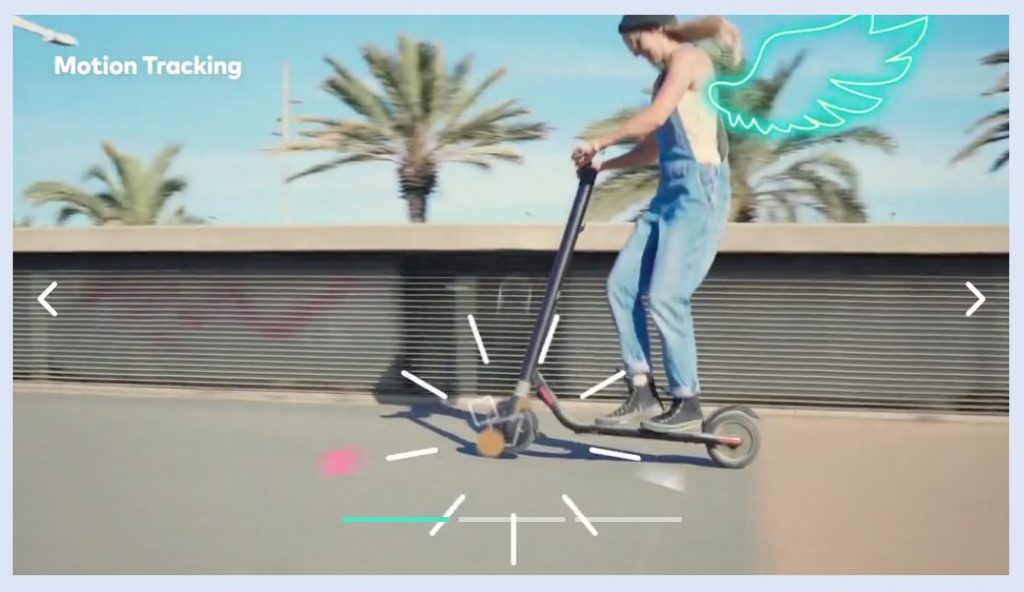
Source: filmora.wondershare.com
Filmora is a powerful and easy-to-use video editor. It’s free to download and comes with everything beginners and professionals need to produce quality videos. You can import video, audio, and images in various formats, edit and arrange these elements in a magnetic timeline,
add effects, filters, titles, and music. And when you're done, videos can be exported in common video formats or shared on social media.
3. Powtoon
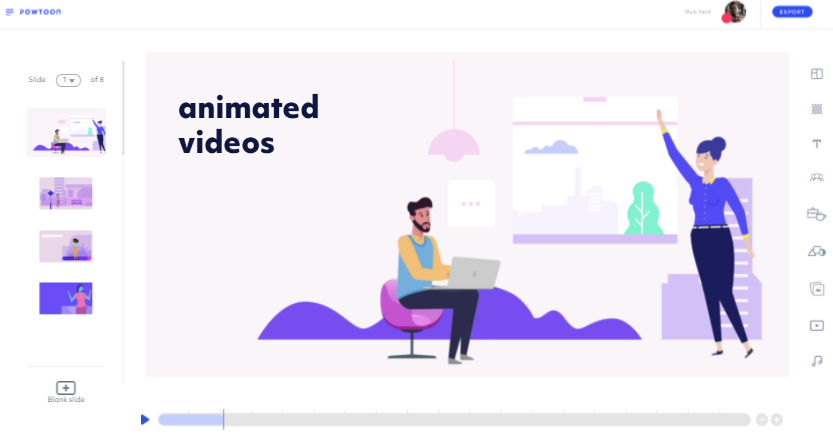
Source: powtoon.com
Powtoon helps you create professional and fully customized videos. Powtoons is also a powerful animation video app and can be used to create short videos. As an online video platform, it comes with a large template gallery, a selection of free soundtracks, and access to royalty-free objects.
4. VideoPad
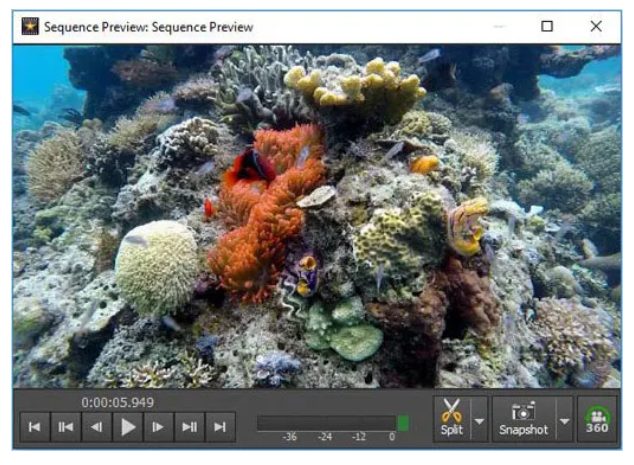
Source: nchsoftware.com
VideoPad is a fully featured video editing software. It supports all popular video formats and has over 50 visual effects. It allows you to perform 3D video editing and 2D to 3D stereoscopic conversion. Add text, overlays, and effects to 360-degree videos, and import and mix music tracks. You can also create custom soundtracks using audio effects with MixPad multi-track mixing software. VideoPad productions can be exported in multiple resolutions, including full HD, 2K, and 4K.
5. Biteable
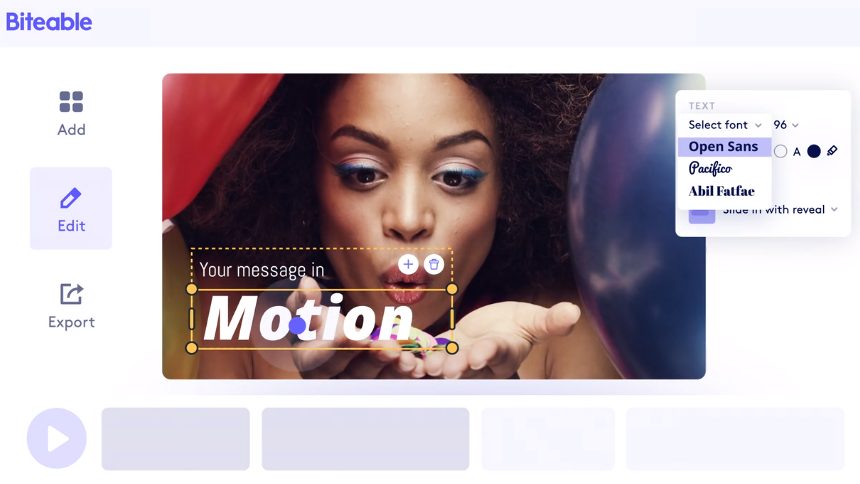
Source: biteable.com
Biteable helps you create stunning videos. You can add stock footage, photos, and soundtracks. Like other online video apps, it’s easy to use and versatile enough to create any kind of video your brand needs. Biteable also comes with templates and a design tool that makes it easy to develop content to help get your message across to your audience.
Where to Promote Your Videos
Having created an effective video, your next important task is promotion. You must get it out and in front of your audience as much as possible. How? Here are four ways to share your videos for maximum reach:
Create a YouTube Channel
If you haven’t yet, invest time in building a YouTube channel. It may seem like work, but it’s a smart move. Your brand isn’t meant to be a flash in the pan, and to reach more people, you’ll need to get in front of them. Given that over 2 billion people use YouTube each month, your audience is definitely there and looking for content that helps solve their problems.
Share Using Social Media Profiles
Social media is another low-hanging fruit. Be sure to leverage your brand’s social media profiles and share videos there. It may sound like overkill, but it’s not. Social media can help great videos spread like wildfire. And because people are wired to want to share valuable and helpful content with their networks, your videos stand a good chance of reaching a large audience.
Use SEO to Optimize Video for Google Search
SEO may seem like a complex undertaking, and in some cases, it can get a little overwhelming. Between concepts like technical SEO, meta descriptions, off-page SEO, and others, you may feel like foregoing SEO for video. Here’s the thing, SEO for video isn’t rocket science. You can quickly and easily optimize your video for search.
Instead of rambling on about how to optimize your videos for search, read Brian Dean’s YouTube SEO: How to Rank YouTube Videos in 2021 blog post. It’s practical, has all you’ll need, and is easy to follow.
Capitalize on Email Marketing
If you have an email list of prospects, it’s time to break it out and share your videos with them. It may not seem like a way to generate tons of traffic, but it can help. Platforms like YouTube and Facebook, use engagement metrics to determine how to rank videos. One of the most important metrics today is watch time. The more and longer people watch your videos, the more platforms see your content as valuable and therefore useful to a wider audience.
Use Paid Advertising
Paid advertising may not be the first idea that crosses your mind when thinking about promotion, but it can be highly effective. Paid ads work because they get content in front of viewers faster. They are also highly targeted, making it possible to reach your ideal customers.
It’s Your Turn
Video marketing is a smart way to reach, educate and convert prospects into customers. But before you start creating videos, set yourself up for success. Get to know your target audience and what drives them, plan your videos using a storyboard, and promote them far and wide using as many platforms as possible.

